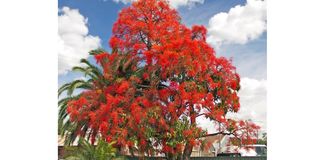You want to have a quality shade at home? Consider flamboyant flame tree

An Illawarra flame tree, which is in the same species as the Royal poinciana. The Royal poinciana has many uses, including for medicines, food, timber and fuel, according to the World Agroforestry Centre.
What you need to know:
- Delonix regia grows best in ecological zones ranging from zero to 2,000 metres above sea level and with annual rains of more than 700mm.
- Flamboyant has many other uses, including for medicines, food, timber and fuel, according to the World Agroforestry Centre.
- The tree’s mature seeds are not known to be eaten. However, research by the World Agroforestry Centre shows that they are a potential nutritious food for humans.
- It has also shown potential for improving liver and kidney functions whilst showing no negative side effects.
Delonix regia, known in English as flamboyant, flame tree or Royal poinciana, is native to Madagascar but grows in many other tropical regions.
In Kenya, it is common in the coastal counties of Kwale, Kilifi, Lamu, Taita Taveta and Tana River. It is called Mkayamba in Kiswahili.
This tree is famous for its flamboyant display of bright orange flowers that resemble claws. Indeed, its scientific name comes from two Greek words “Delo” and “Onyx”, which mean “conspicuous” and “claw” respectively.
Delonix regia grows best in ecological zones ranging from zero to 2,000 metres above sea level and with annual rains of more than 700mm.
Its roots are wide-spreading, which enables the tree to withstand strong storms. They also make the tree ideal for erosion control, and for soil rehabilitation and improvement through atmospheric nitrogen fixation.
The downside is that the roots do not allow any other vegetation to grow under the canopy. In addition, they are notorious for damaging concrete structures if planted too close.
Flamboyant has many other uses, including for medicines, food, timber and fuel, according to the World Agroforestry Centre.
It is also grown as an ornamental tree. Its umbrella-shaped canopy, which can be wider than its height, provides good shade. At the Coast, it is common in the lawns of many hotels.
Food
The tree’s mature seeds are not known to be eaten. However, research by the World Agroforestry Centre shows that they are a potential nutritious food for humans.
They contain around 48 per cent carbohydrate, 8.7 per cent protein and 17.2 per cent fats, plus a good range of minerals.
A study in Nigeria, “Chemical and nutritional compositions of flame of forest (Delonix regia) seeds and seed oil,” carried out in 2017 by Oyedeji O.A.; Azeez L.A.; and Osifade B.G. established that the seeds are high in sodium, which could lead to heart problems in later life if they become a major part of the diet.
Nutritionists say eating the seeds with foods rich in potassium and low in sodium would restore a balance.
Medicine
The leaves, flowers, seeds and bark of this tree contain compounds and have been used in traditional medicine for ages.
The diseases they treat include constipation, roundworms, inflammation, rheumatoid arthritis, diabetes, pneumonia and malaria.
The study, “Delonix regia Leaf Extract: A potential therapeutic agent for cardio-protection,” by Lung-Shuo Wang; Chun-Ting Lee; Wei-Lieh Su; Shih-Che Huang found the tree to have anti-bacterial, anti-diabetic, anti-diarrhoeal, antifungal, anti-inflammatory, anti-malarial, anti-microbial, antioxidant, cardio-protective, gastro-protective, hepato-protective and wound healing activity.
Another study, “Analgesic activity of the methanol leaf extract of Delonix regia,” by Ezeja M.I.; Ezeigbo I.I.; Madubuike K.G. and Ekpe I.J., published in the Nigerian Veterinary Journal in 2012 established that its active compounds include flavonoids and triterpenes that have analgesic activities and are also powerful antioxidants.
It has also shown potential for improving liver and kidney functions whilst showing no negative side effects.
Propagation
Delonix regia is propagated mainly by seed, which cost Sh1,000 a kilo at Kenya Forestry Research Institute (Kefri) seed centres. The seed has a hard coat thus requires pre-sowing preparation to germinate.
To break this dormancy, the seed needs to be scarified, (making a small incision in the coat), while being careful not to damage the embryo.
Alternatively, a small quantity of near-boiling water can be poured over the seed, which is then soaked for 12-24 hours in warm water.
Treated seeds sown in unshaded nursery beds sprout within 5-10 days, with a germination rate of up to 90 per cent.
The seeds store extremely well and can have a nearly 50 per cent germination rate even after nine years.




